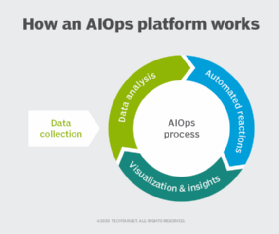
Getty Images/iStockphoto
What are hyperautomation use cases for IT operations?
Fully automated NoOps workflows might not be possible, but there's always room to further automate existing processes. An expert explains two hyperautomation use cases for DevOps.
Automating processes saves time and reduces tedium. But sometimes, basic automation isn't enough.
To maximize efficiency and reliability, businesses are increasingly turning to hyperautomation, a strategy that uses innovative methodologies and technologies to double down on the value of automation.
Hyperautomation is the process of identifying opportunities to increase efficiency in workflows that are already partly automated but could be further optimized. Ultimately, the goal of hyperautomation is to completely automate all aspects of every IT or DevOps process in an organization.
There's debate about whether it's possible to achieve total automation, otherwise known as NoOps. But most IT practitioners can agree that there are almost always opportunities to increase automation and optimization in development and ops workflows.
Hyperautomation use cases
To understand what hyperautomation looks like in practice, consider these hyperautomation use cases.
Automate the development stage of CI/CD pipelines
Many businesses today have adopted the DevOps practice of CI/CD pipelines, which make software development more efficient by automating many of the processes required to create software.
Actually writing code, however, is one stage of the CI/CD pipeline that usually remains manual. In most cases, software developers still sit down and write source code by hand, line by line.
A business pursuing hyperautomation might choose to automate the coding process by taking advantage of low-code or no-code development tools. Because these tools minimize the amount of code that software engineers must write manually, they bring development closer to complete automation.
Collect, analyze and react to data with AIOps platforms
Modern IT ops teams have a range of tools at their disposal to automate tedious tasks. They can automatically provision infrastructure using infrastructure as code, for example, and automate aspects of monitoring and alerting with observability tools.

But standard IT automation tools are of limited value when complex challenges arise -- for example, when there is no immediately obvious root cause for a server failure, or when IT engineers receive a string of alerts and aren't sure which to prioritize. These aspects of IT ops work can be hyperautomated using AIOps tools.
AIOps platforms use machine learning models to derive complex insights that humans would struggle to develop manually due to the vast amounts of data they'd have to sort through. Using AIOps tools can bring IT ops teams a step closer to complete automation.
Hyperautomation is a concept, not a practice
To understand the use cases for hyperautomation, it's important to remember that hyperautomation is a concept, not a specific practice or tool.
Businesses that embrace hyperautomation are constantly on the lookout for ways to optimize automated processes, but there is no specific script to follow. You can't just buy a hyperautomation tool or hire a hyperautomation engineer and consider your business hyperautomated.
In this sense, hyperautomation is similar to concepts like digital transformation. As a broad goal, working toward hyperautomation can bring real value to IT organizations and DevOps teams. But it's up to businesses to decide how best to pursue and implement the approach.







